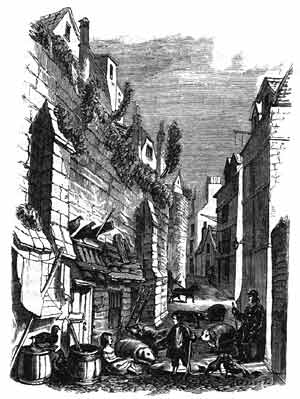Social Taphonomy: Agency, Biography and Chaîne Opératoire of Cattle Bones in a Mediaeval European City
Towns and cities are, for some, a defining feature of complex societies (e.g. Cohen, 1976; Basham, 1978) and are, in themselves, complex entities where a variety of different human activities are carried out and where the resultant archaeological signatures of those activities are usually entangled. That archaeological contexts are usually the result of several different activities, or of the result of the same activity being carried out many different times, is one reason that the archaeological record should be imperfect. The imperfection of the record is usefully employed by zooarchaeologists, who regularly combine different contexts in order to form larger, more statistically viable, samples for site-wide but period-specific interpretations of economies and the environment.
It should not be lost sight of, though, that the combining of several different contexts, however much it may decrease the potential error of assumptions, is facilitated by the broad similarity of many contexts. Most archaeological contexts, including those producing faunal material, are essentially heterogeneous in nature and so it becomes easier to consider them en masse. This simple underlying principle is highlighted by the fact that the many zooarchaeological studies which consider a particular activity are often prompted by the discovery of a context or other assemblage which is unusual for its homogeneity in one way or another (i.e. the almost or total dominance of one animal, species or skeletal element or selection of elements) (e.g. Driver, 1984; Morris, 2008; Broderick, 2012). This focus on identifying activities through unusual deposits can only mask the true extent and frequency of such activities, perhaps even concealing some altogether, so significantly altering our understanding of life in the societies studied.
This project forms the basis of my PhD research and seeks to identify a method for revealing these activities (pre-depositional taphonomies) through the use of new models and statistical tests, so furthering our understanding of the zooarchaeological record and, thus, the people that are the focus of archaeology. By focusing research on the urban environment, it will be shown that patterns can be identified in even the most complex assemblages, deriving their material from a multitude of different processes and activities – often several acting sequentially on the same material.
Selected presentations:
- Broderick, L.G., 2010. Whatever Happened to Exeter?, Theoretical Archaeology Group (TAG) 32nd Annual Meeting at the University of Bristol.
- Broderick, L.G., 2011. The Economy and Ecology of Historic Exeter, 4th Applied Sciences Post-Graduate Conference at Bournemouth University.
- Broderick, L.G., 2012. No Bones About the South West, Yorkshire Archaeology Postgraduate Group (YAPG) conference at the University of York.
